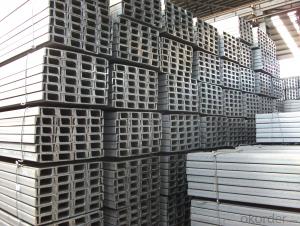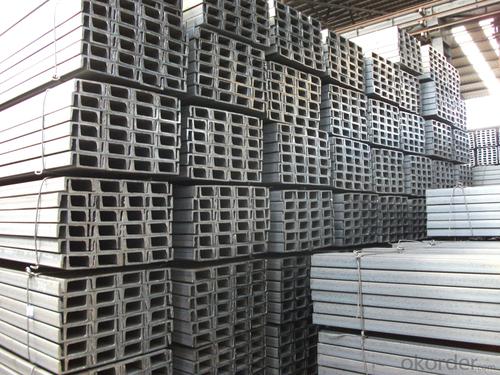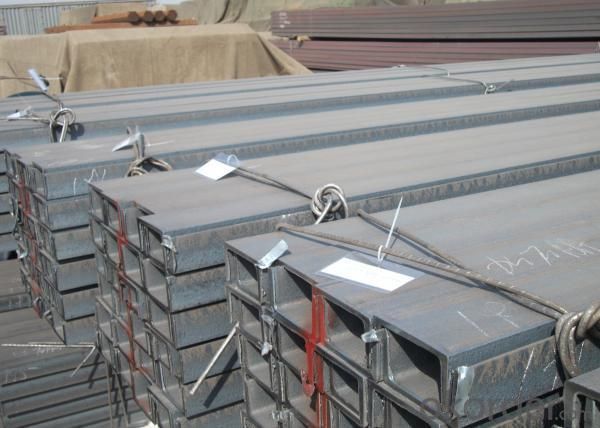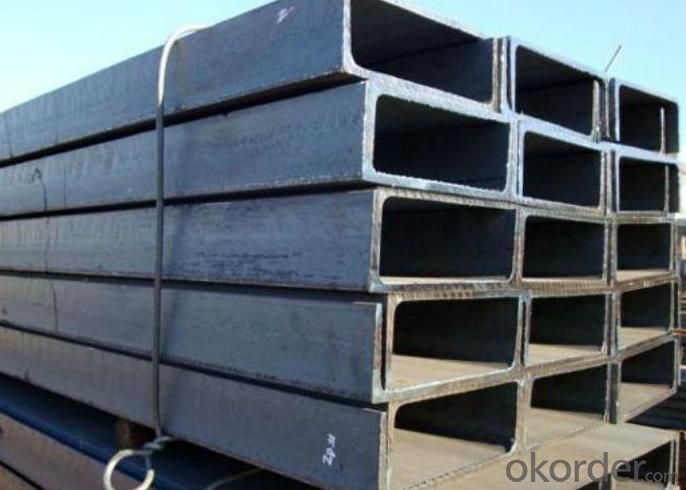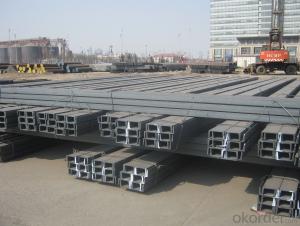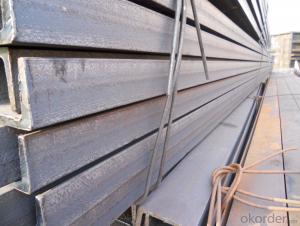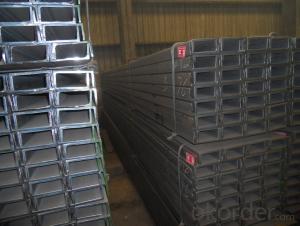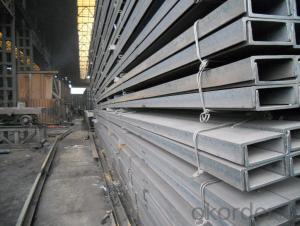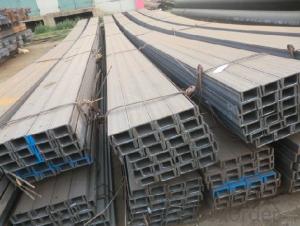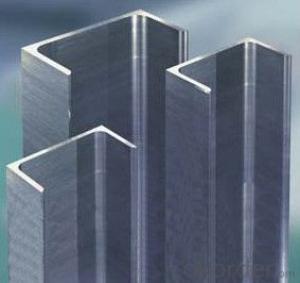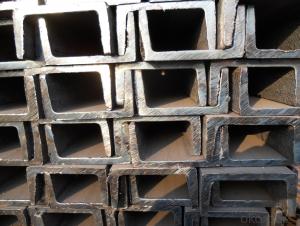Alloy Low Carbon Steel U Channel UPN EN Standard
- Loading Port:
- Tianjin
- Payment Terms:
- TT or LC
- Min Order Qty:
- 200 m.t.
- Supply Capability:
- 5000 m.t./month
OKorder Service Pledge
OKorder Financial Service
You Might Also Like
OKorder is offering Alloy Low Carbon Steel U Channel UPN at great prices with worldwide shipping. Our supplier is a world-class manufacturer of steel, with our products utilized the world over. OKorder annually supplies products to African, South American and Asian markets. We provide quotations within 24 hours of receiving an inquiry and guarantee competitive prices.
Product Applications:
Alloy Low Carbon Steel U Channel UPN are ideal for structural applications and are widely used in the construction of buildings and bridges, and the manufacturing, petrochemical, and transportation industries.
Product Advantages:
OKorder's Alloy Low Carbon Steel U Channel UPN are durable, strong, and wide variety of sizes.
Main Product Features:
· Premium quality
· Prompt delivery & seaworthy packing (30 days after receiving deposit)
· Can be recycled and reused
· Mill test certification
· Professional Service
· Competitive pricing
Product Specifications:
Manufacture: Hot rolled
Grade: Q195 – 235
Certificates: ISO, SGS, BV, CIQ
Length: 6m – 12m, as per customer request
Packaging: Export packing, nude packing, bundled
UPN U CHANNEL | Standard
h | Sectional
b | Dimension
s |
T | Mass:
Kg/m |
(mm) | (mm) | (mm) | (mm) | ||
80x45 | 80 | 45 | 6.0 | 8.0 | 8.64 |
100X50 | 100 | 50 | 6.0 | 8.5 | 10.6 |
120x55 | 120 | 55 | 7.0 | 9.0 | 13.4 |
140x60 | 140 | 50 | 7.0 | 10.0 | 16.0 |
160x65 | 160 | 65 | 7.5 | 10.0 | 18.8 |
180x70 | 180 | 70 | 8.0 | 11.0 | 22.0 |
FAQ:
Q1: Why buy Materials & Equipment from OKorder.com?
A1: All products offered byOKorder.com are carefully selected from China's most reliable manufacturing enterprises. Through its ISO certifications, OKorder.com adheres to the highest standards and a commitment to supply chain safety and customer satisfaction.
Q2: How do we guarantee the quality of our products?
A2: We have established an advanced quality management system which conducts strict quality tests at every step, from raw materials to the final product. At the same time, we provide extensive follow-up service assurances as required.
Q3: How soon can we receive the product after purchase?
A3: Within three days of placing an order, we will arrange production. The normal sizes with the normal grade can be produced within one month. The specific shipping date is dependent upon international and government factors, the delivery to international main port about 45-60days.
Images:
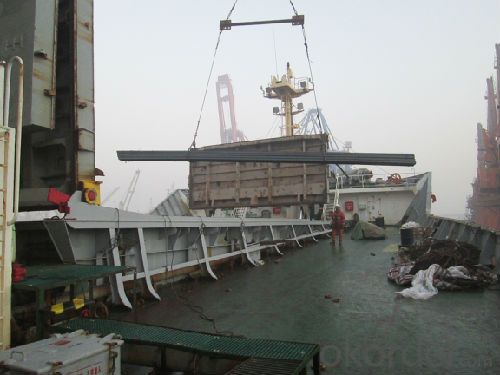
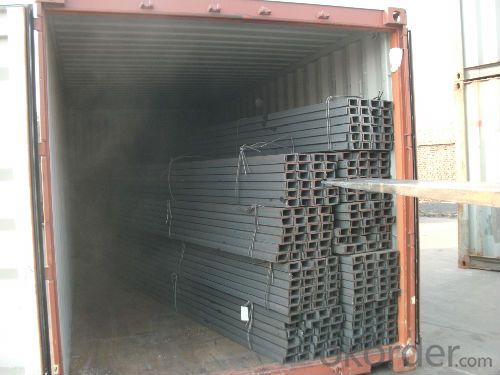
- Q: What are the different surface finishes available for steel channels?
- There are several different surface finishes available for steel channels, each offering unique benefits and applications. Some of the most common surface finishes include: 1. Hot-Dip Galvanized: This process involves dipping the steel channel into a bath of molten zinc, which creates a protective coating on the surface. Hot-dip galvanizing provides excellent corrosion resistance, making it ideal for outdoor applications or environments with high humidity or exposure to chemicals. 2. Powder Coating: Powder coating involves applying a dry powder to the steel channel's surface, which is then heated to form a durable, protective layer. This finish is available in a wide range of colors and provides excellent resistance to chipping, scratching, and fading. Powder coating is often used for decorative purposes or in applications where aesthetics are important. 3. Electroplating: Electroplating involves depositing a layer of metal, such as chrome or nickel, onto the steel channel's surface through an electrolytic process. This finish enhances the channel's appearance, provides corrosion resistance, and can also improve the channel's hardness or wear resistance, depending on the plated metal. 4. Painted: Steel channels can be painted using various types of coatings, such as epoxy, acrylic, or enamel. Painting provides both aesthetic appeal and protection against corrosion. Different types of paints can be chosen based on the desired level of durability, weather resistance, and color options. 5. Stainless Steel: Steel channels can also be manufactured from stainless steel, which inherently provides corrosion resistance. Stainless steel channels are commonly used in applications where hygiene, high temperatures, or exposure to aggressive chemicals are a concern. The choice of surface finish for steel channels depends on the specific requirements of the application, including the desired level of corrosion resistance, durability, aesthetics, and environmental factors. Consulting with a steel supplier or surface finishing expert can help determine the most suitable finish for a particular project.
- Q: Can steel channels be used for ceiling installations?
- Yes, steel channels can be used for ceiling installations. Steel channels are commonly used in construction for their strength and durability. They provide a secure and stable base for suspending or mounting various components of a ceiling system, such as electrical fixtures, HVAC ducts, and acoustic panels. Steel channels also allow for easy installation and adjustment, making them a popular choice for both residential and commercial ceiling applications. Additionally, they offer excellent load-bearing capacity, ensuring that the ceiling structure remains stable and secure.
- Q: What are the typical finishes available for steel channels?
- The typical finishes available for steel channels include hot-dip galvanized, powder coated, painted, and bare steel.
- Q: Can steel channels be used for fencing applications?
- Yes, steel channels can be used for fencing applications. Steel channels are strong and durable, making them suitable for various fencing purposes. They can be used to create the framework for a fence, providing stability and support. Steel channels can also be used as posts or rails in fencing systems, offering strength and rigidity. Additionally, steel channels can be easily welded together, allowing for customization and the creation of different fencing designs. Overall, steel channels provide a reliable and long-lasting option for fencing applications.
- Q: What is the difference between channel steel and C steel?
- Channel steel is rail steel, relatively thick. C steel is rolled by iron plate
- Q: Can steel channels be galvanized?
- Yes, steel channels can be galvanized. Galvanization is a process of applying a protective zinc coating to steel to prevent rusting and corrosion. Galvanizing steel channels can provide long-lasting protection and can be done through either hot-dip galvanizing or electroplating methods. Hot-dip galvanizing involves immersing the steel channel in a bath of molten zinc, while electroplating involves using an electric current to deposit a layer of zinc onto the steel surface. Galvanized steel channels are commonly used in various industries, including construction, infrastructure, and manufacturing, due to their enhanced durability and resistance to environmental factors.
- Q: Can steel channels be used for creating support structures for plumbing systems?
- Yes, steel channels can be used for creating support structures for plumbing systems. Steel channels are known for their strength and durability, making them suitable for supporting the weight of plumbing pipes and fixtures. They provide a stable and secure base for plumbing systems, ensuring that pipes are properly supported and aligned. Steel channels also have high load-bearing capacities, enabling them to withstand heavy loads and prevent sagging or bending of the pipes over time. Additionally, steel channels can be easily customized and fabricated to meet the specific requirements of the plumbing system, making them a versatile choice for creating support structures.
- Q: Can steel channels be welded or joined together?
- Steel channels can indeed be welded or joined together. Welding is a widely utilized technique for connecting steel channels and establishing a robust joint. In this process, the steel channels are heated to a high temperature, causing the edges to melt and subsequently fuse together as they cool. This fusion creates a bond that is equal to, if not surpassing, the strength of the original steel. Alternative methods for joining steel channels include bolting or using specialized connectors. Nevertheless, welding is often the preferred choice due to its capability to produce a seamless and uninterrupted connection, leading to a more structurally stable joint.
- Q: How do steel channels contribute to the overall acoustics of a building?
- The overall acoustics of a building can be significantly affected by steel channels. These channels are commonly used as structural components in the construction of walls, ceilings, and floors. The manner in which these channels are installed and connected in a building can impact the way sound travels through the space. One way in which steel channels impact the acoustics of a building is by offering a rigid structure that aids in controlling sound transmission. When installed correctly, steel channels can decrease the transfer of sound vibrations between different areas of the building. This is particularly important in spaces where privacy and noise control are crucial, such as offices, conference rooms, or residential units. Furthermore, steel channels can be utilized to establish acoustic isolation between different rooms or floors. By suspending ceilings or creating floating floors using steel channels, vibrations and impact noise can be minimized. This is especially vital in spaces where activities such as music recording, theaters, or classrooms take place, as it assists in preventing unwanted noise from traveling between rooms. Additionally, steel channels can enhance the sound quality within a space by providing a sturdy mounting surface for acoustical treatments such as sound-absorbing panels, diffusers, or bass traps. These treatments can be strategically positioned on the steel channels to enhance the overall clarity and balance of sound within a room, reducing echoes and reverberations. In conclusion, steel channels play a critical role in the overall acoustics of a building by controlling sound transmission, providing acoustic isolation, and allowing for the integration of acoustical treatments. Proper utilization of steel channels during the construction process can help create a comfortable, functional, and acoustically optimized environment for various applications.
- Q: Are steel channels suitable for modular construction practices?
- Yes, steel channels are suitable for modular construction practices. Steel channels provide excellent strength and durability, making them ideal for use in modular construction. They are commonly used in the construction of modular buildings, as they offer a reliable and sturdy framework for the structure. Steel channels are also versatile and can be easily customized to meet specific design needs, allowing for flexibility in modular construction. They can be cut, welded, and shaped according to the required dimensions, making them highly adaptable for modular construction projects. Furthermore, steel channels are lightweight compared to other construction materials, which makes them easier to transport and assemble in modular construction practices. This characteristic also contributes to the overall efficiency of modular construction, as it reduces time and labor costs during installation. In addition to their strength, versatility, and lightweight nature, steel channels are also resistant to corrosion, fire, and pests, ensuring the longevity and safety of modular structures. These properties make steel channels a reliable and suitable choice for modular construction practices.
Send your message to us
Alloy Low Carbon Steel U Channel UPN EN Standard
- Loading Port:
- Tianjin
- Payment Terms:
- TT or LC
- Min Order Qty:
- 200 m.t.
- Supply Capability:
- 5000 m.t./month
OKorder Service Pledge
OKorder Financial Service
Similar products
Hot products
Hot Searches
Related keywords
